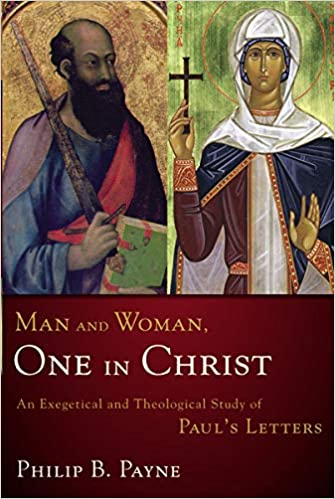
BOOK REVIEW: MAN AND WOMAN, ONE IN CHRIST
At his instruction, Philip Payne’s wife promised in her marital vows to submit to his leadership. Philip Payne (Ph.D.) is a New Testament professor known for his textual criticism studies. Years later, in 1973, Payne’s assumption of the validity of male headship was challenged. A New Testament scholar’s emphatic statement that a proper, contextual understanding of Scripture uncovers no passage affirming women’s exclusion from any Christian ministry gave him pause. Soon after, he began a thirty-six-year study of the Scriptures. He wanted to determine whether they prescribe a hierarchy of men over women. In his 2009 book, Man and Woman, One in Christ: An Exegetical and Theological Study of Paul’s Letters, Payne affirms his belief in biblical inerrancy and the equality of men and women in all spheres.
Women: Equals in the Church and Home
His lengthy, detailed, and well-researched book is not light reading. However, Payne’s research contributes significantly to the debate on whether the Bible teaches male headship in the church and home. Payne provides many biblical, theological, exegetical, and cultural context arguments to support his view that women should be welcomed as equals into the realm of leadership in the church. And, if married, to live in mutuality with their husbands.
Organization of the Book
The book’s twenty-four chapters are organized in the chronological order of Paul’s letters to the churches. An intentional ordering to illuminate the consistency of Paul’s principles regarding Christian men and women. In addition to footnotes, the book contains a select bibliography and five unique indexes, including a “Significant Hebrew Word Index” and “Significant Greek Work Index.”
The first three chapters discuss significant influences on Paul: background related to his view of women—Hellenism and Judaism contrasted with the influence of Jesus, Scripture, and Gamaliel (Paul’s rabbinic teacher); his female co-workers; and his guiding theological principles. Part I, chapters 4–14, provides an exegesis of Paul’s “Earlier Letters” on women. These are Galatians 3:28; 1 Corinthians 7; 1 Corinthians 11:2–16; and 1 Corinthians 14:35–35. Part II, chapters 15–24, provides the “Later Letters” on women. Which are Ephesians 5:21–33; Colossians 3:18–19; I Timothy 2:8–15; 1 Timothy 3:1–13 and Titus 1:5–9.
Three Significant Arguments
Here are three of Payne’s significant arguments for women in church leadership:
- Payne argues that a woman can be a church leader, including an elder or senior pastor, from several vantage points. He highlights the three-letter Greek word, τις, which means “someone” or “anyone” or “whoever.” This word is in 1 Timothy 3:1: “If someone [τις] aspires to the office of overseer…” and in verse 5, “if someone [τις] does not know how to manage one’s own household…” And, it is in Titus 1:6, a verse stating qualifications for elders, “if anyone [τις] is above reproach…” Τις is gender-neutral, and Paul used it in each of these verses describing elders. So, Payne questions restricting women from this role.
- In our English translations, male pronouns are liberally sprinkled across 1 Timothy 3:1–12 and Titus 1: 6–9, the passages describing the requirements for church leadership offices. But, there are NO male pronouns in the original Greek in these passages.
- The Greek term for “head” (kephale) in Ephesians 5:23, “For the husband is the head of the wife as Christ is the head of the church, his body, of which he is the Savior,” has had much ink spilled explaining its intended definition. Payne examined the grammar and noted that Christ as the church’s “head” is appositionally linked with “savior.” Christ’s relationship is not defined in the sense of his authority over the body, his church, but in verses 25–32, Christ gives of himself in nourishing love (v. 25), cleansing her to make her blameless (v. 26–27), and feeding and caring for her (v. 29). Paul does not tell husbands to assume authority over their wives; he instead declares husbands are to imitate Christ in how they love their wives (v. 28–31, 33).
Analyzing 1 Timothy 2 and 1 Corinthians 14
Payne concludes his book with several points that underscore his conviction that Paul consistently affirmed women and their ministry, advocated for Christian women’s equality with men, and championed their ministry work. First, the author reiterates Paul’s significant influences: Jesus, the Scriptures, the Spirit, and Gamaliel. Second, he cites two Bible passages, I Timothy 2:12 and 1 Corinthians 14:34–35, the most referred to passages used to restrict women’s work in the church. Regarding the former, he describes three Greek grammar issues that bring context to support that 1 Timothy 2 is meant as a specific prohibition for a localized group because of false teaching. Paul’s prohibition of select women “assuming authority for themselves to teach men” was not intended to establish a universal prohibition of women. He believes the latter is an interpolation. This means in Payne’s view, verses 34 and 35 of 1 Cor 14 were not originally in the ancient Greek text. However, there is no scholarly consensus that these verses are an interpolation.
Conclusion
Finally, Payne laments the isolated interpretation of each story of a woman leader in the Bible—considered opposing evidence—against the plain reading of 1 Timothy 2. Employing a visual metaphor, he writes, “Just as the totality of the avalanche is inescapable, so the totality of the Scriptures’ affirmations of women leading God’s people is inescapable.” And he concludes that the scriptural evidence “is as strong as an avalanche (p. 462)” against the view that women must not teach or exercise authority over men.